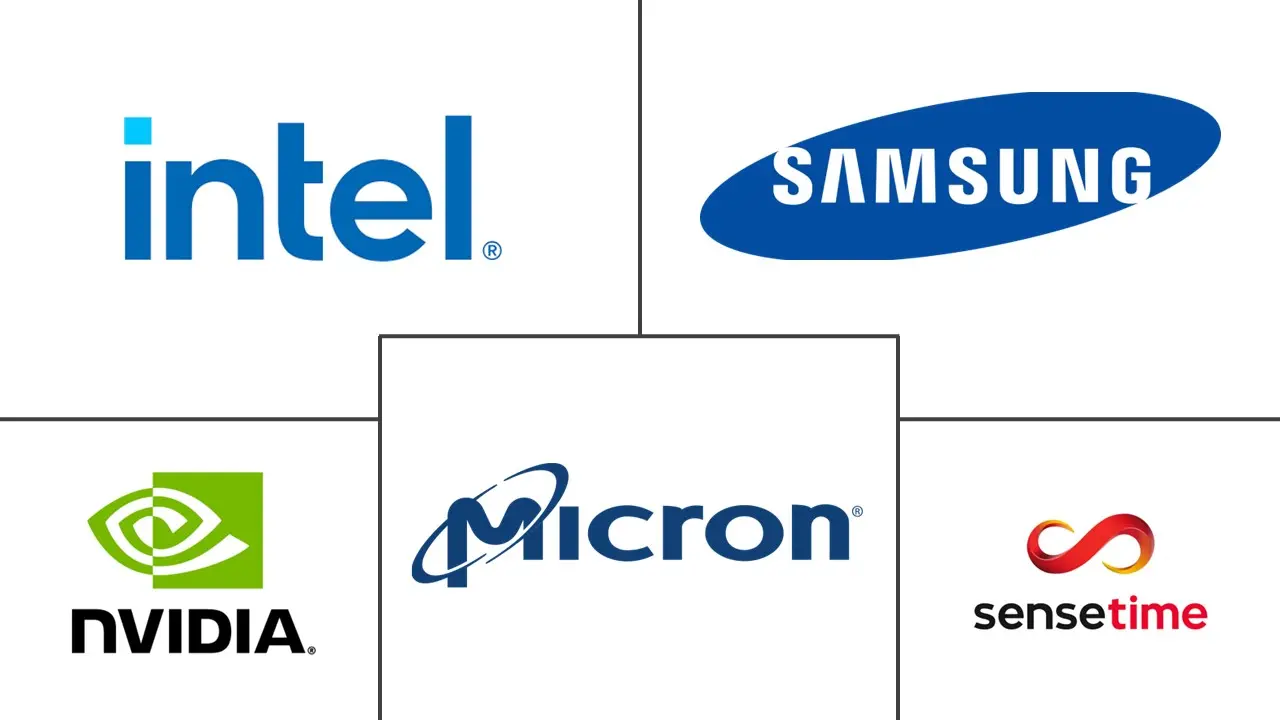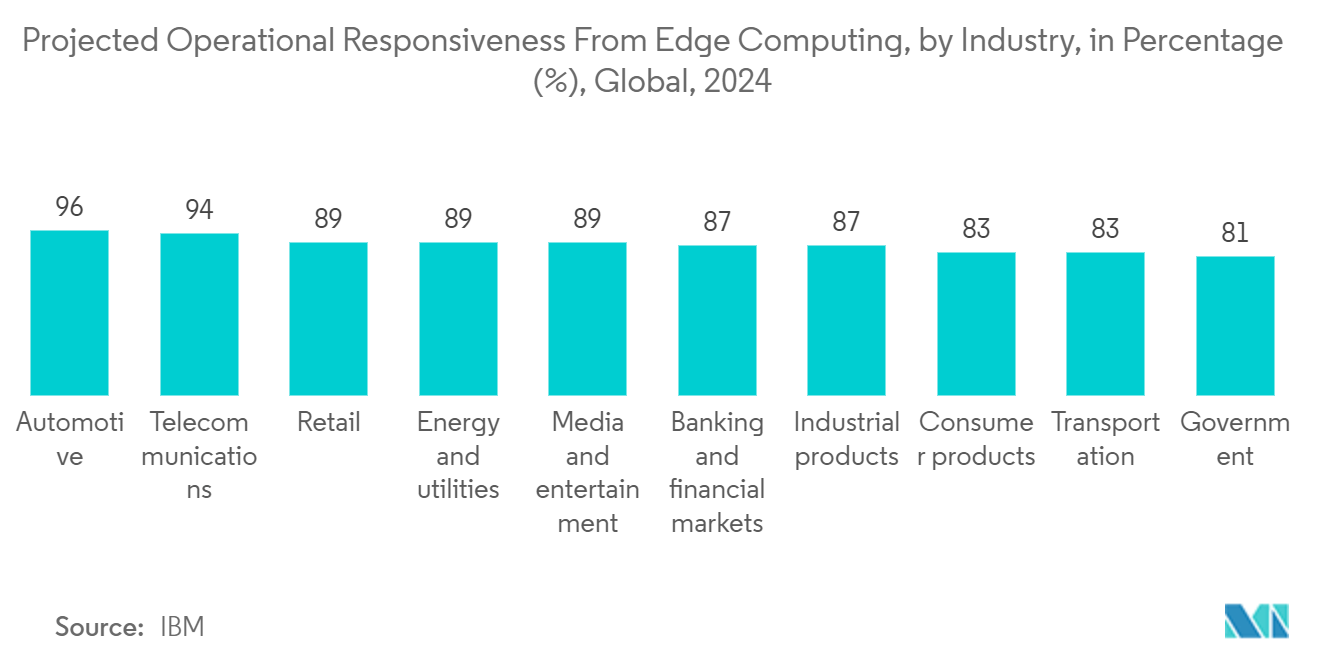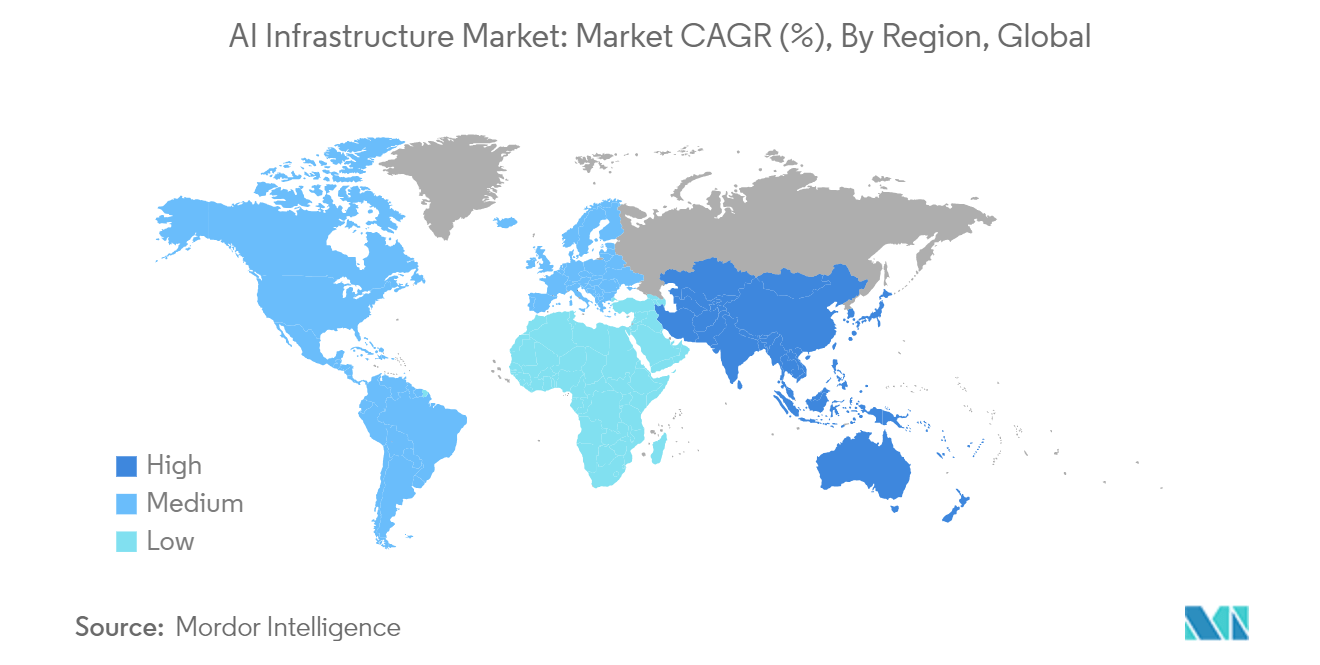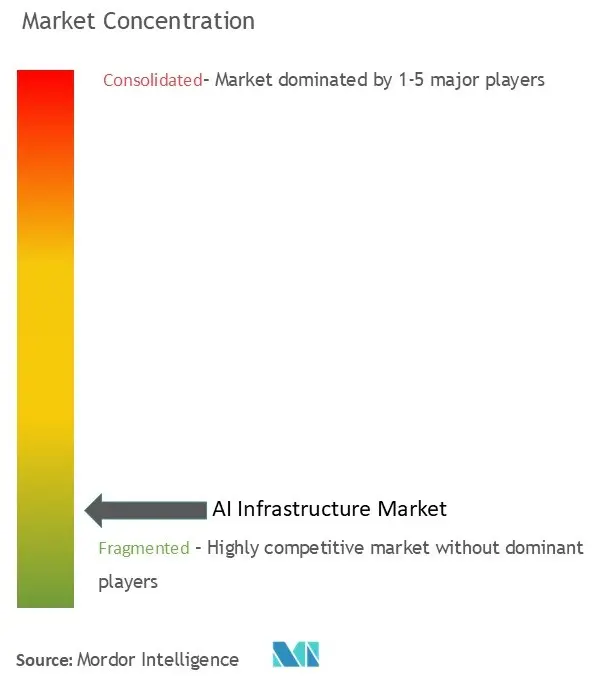AI Infrastructure Market Size

| Study Period | 2019 - 2029 |
| Market Size (2024) | USD 68.46 Billion |
| Market Size (2029) | USD 171.21 Billion |
| CAGR (2024 - 2029) | 20.12 % |
| Fastest Growing Market | Asia Pacific |
| Largest Market | North America |
Major Players
*Disclaimer: Major Players sorted in no particular order |
AI Infrastructure Market Analysis
The AI Infrastructure Market size is estimated at USD 68.46 billion in 2024, and is expected to reach USD 171.21 billion by 2029, growing at a CAGR of 20.12% during the forecast period (2024-2029).
AI Infrastructure Market: Driving Innovation and Efficiency
- Demand Surge in High-Performance Computing Data Centers: The AI Infrastructure market is experiencing exponential growth, driven by increasing demand for AI hardware in high-performance computing (HPC) data centers. Businesses are realizing the transformative potential of artificial intelligence, fueling investments across various industries.
- Nvidia's BlueField-3 DPU: This technology, the world’s first 400GbE data processing unit (DPU), is ten times faster than its predecessor, underscoring significant advancements in AI hardware.
- Google Cloud and Intel Collaboration: These tech giants jointly developed a chip designed to enhance AI capabilities, security, and productivity in data centers, marking a trend of strategic partnerships.
- AMD's MI300X Series: Advanced Micro Devices Inc. introduced the MI300X chip series, enabling the execution of generative AI models with up to 80 billion parameters, demonstrating the escalating complexity of AI models.
- IIoT and Automation Technologies Propelling Growth: The integration of Industrial Internet of Things (IIoT) and automation technologies is significantly boosting the AI Infrastructure market. These innovations are enhancing efficiency, optimizing processes, and generating valuable data.
- AFCOM 2021 Study Results: Over 40% of participants plan to deploy robotics and automation in data center monitoring and maintenance by 2024, signaling a sharp rise in automation.
- Advantech and Actility Integration: These companies launched an AI-based solution for machine prognostics and health management, enabling real-time machine status monitoring.
- TD SYNNEX's Data-IoTSolv: This solution suite equips partners with tools for leveraging data analytics and IoT, illustrating the growing demand for AI-powered IoT solutions.
- Machine Learning and Deep Learning Driving Innovation: Machine learning and deep learning technologies are critical drivers of AI infrastructure growth, empowering companies to extract valuable insights from massive datasets.
- TAZI.AI's Funding Success: The startup secured $4.6 million to roll out machine learning solutions in healthcare, insurance, and pharmaceuticals, highlighting sector-specific AI adoption.
- Government Sector Utilization: Machine learning is increasingly used in government sectors to automate operations and analyze data, freeing human resources for core functions.
- Pandemic-Era Acceleration: The pandemic sped up AI and ML adoption for network automation, with network providers recognizing the essential role of AI in operational streamlining.
- Data Explosion in Automotive and Healthcare Sectors: The growing volume of data in industries like automotive and healthcare is propelling the need for advanced AI technologies to manage and analyze data efficiently.
- Alpine Health Systems’ AI-Powered Platform: This platform simplifies hospital discharge processes for patients with complex medical conditions, demonstrating AI’s potential in healthcare management.
- Intangles Lab’s Ambient Cognitive AI for EVs: This innovation addresses range anxiety in electric vehicles, particularly in the commercial EV sector.
- AI in Healthcare Applications: AI is increasingly used for clinical decision-making, disease diagnosis, and patient data management, showcasing its versatility in healthcare.
- Market Landscape and Future Outlook: The AI Infrastructure market is poised for sustained growth, led by a mix of tech giants, startups, and cloud providers delivering cutting-edge solutions.
- Cloud Segment Growth: The AI Infrastructure cloud market, valued at $16.12 billion in 2022, is forecasted to reach $49.29 billion by 2028, reflecting a CAGR of 20.22%.
- North American Market Leadership: North America led the AI infrastructure market in 2022 with $19.57 billion in value, projected to hit $56.59 billion by 2028, growing at a 19.10% CAGR.
- Emerging Technologies: Innovations like quantum computing, 6G connectivity, and advanced robotics are expected to push the boundaries of AI infrastructure capabilities, enabling new applications and use cases.
AI Infrastructure Market Trends
Hardware Segment Cornerstone of AI Infrastructure
- Market Size and Growth: The hardware segment is the backbone of the AI Infrastructure market. In 2022, it accounted for 73.70% of the market share, valued at $34.52 billion. It is expected to grow at a CAGR of 19.19%, reaching $100.29 billion by 2028.
- Processor Subsegment Leads: Processors were valued at $20.73 billion in 2022 and are forecasted to reach $57.56 billion by 2028, driven by the increasing complexity of AI algorithms requiring more powerful processing.
- Customization Trend: Companies are shifting towards custom AI chips, like Huawei's Ascend 910 AI processor, which demonstrated twice the training speed of common cards using TensorFlow.
- Edge Computing Influence: The rise of edge computing is shaping AI processor development. Manufacturers are focusing on processors that enable real-time data processing at the point of use, particularly in IoT applications.
- Hybrid Processors: Companies are developing hybrid AI processors that combine CPUs with GPUs or Neural Processing Units (NPUs), enhancing versatility and efficiency for diverse AI applications.

North America to Hold Major Market Share
Cloud Segment: Catalyst for AI Democratization
- Rapid Growth Trajectory: The cloud segment, valued at $16.12 billion in 2022, is projected to grow at a 20.22% CAGR, reaching $49.29 billion by 2028. This growth is outpacing the overall market CAGR, signaling the critical role of cloud solutions in AI infrastructure.
- Democratization of AI: Cloud-based AI infrastructure lowers adoption barriers, making AI technologies accessible to businesses of all sizes. This democratization accelerates digital transformation and fosters innovation.
- Scalability and Flexibility: Cloud platforms offer unmatched scalability, enabling enterprises to easily manage AI workloads, such as model training and inference, which are data-intensive.
- AI-as-a-Service Proliferation: The rise of AI-as-a-Service (AIaaS) allows companies to access pre-trained models and toolsets. For example, Nvidia's DGX Cloud offers supercomputing services for AI model training, while Salesforce’s AI Cloud delivers enterprise-ready AI tools.
- Strategic Collaborations: Collaborations between AI hardware providers and cloud platforms, such as Google Cloud’s partnership with Singapore’s Smart Nation initiative, are creating sector-specific AI cloud solutions.
- Market Outlook: The AI Infrastructure market will continue to evolve with the hardware and cloud segments developing synergistically. As AI applications proliferate, the demand for scalable, robust infrastructure will grow, spurring further specialization in AI hardware and cloud-native solutions.

AI Infrastructure Industry Overview
Tech Giants Lead the Market: The AI Infrastructure market is dominated by tech giants like Intel, Nvidia, IBM, Microsoft, and Samsung. These companies hold significant market share due to their extensive resources, comprehensive AI solutions, and global reach.
Nvidia’s DGX Cloud Service: This AI supercomputing service enables businesses to train sophisticated generative AI models, showcasing the company’s leadership in providing end-to-end AI infrastructure solutions.
IBM and Microsoft Hybrid Solutions: Both companies have developed hybrid cloud solutions that integrate AI capabilities, empowering enterprises to deploy AI across various environments efficiently.
Substantial R&D Investments: Leading players invest heavily in research and development to maintain their competitive edge, ensuring they stay at the forefront of AI technology advancements.
Innovation and Specialization Drive Market Success: Success in the AI Infrastructure market hinges on continuous innovation and industry-specific specialization.
Cisco’s Generative AI Solutions: Cisco introduced new network, security, and observability offerings powered by generative AI, highlighting the importance of innovation in gaining a competitive edge.
Mphasis.ai’s Industry Focus: Mphasis focuses on integrating AI capabilities into existing technological environments, optimizing operational efficiency in specific sectors.
Strategic Partnerships: Google Cloud’s expansion of AI consulting services exemplifies how companies can leverage strategic collaborations to broaden their offerings and tap into new markets.
AI Infrastructure Market Leaders
-
Intel Corporation
-
Nvidia Corporation
-
Samsung Electronics Co. Ltd
-
Micron Technology Inc.
-
Sensetime Group Inc.
*Disclaimer: Major Players sorted in no particular order

AI Infrastructure Market News
- September 2024 - BlackRock and Microsoft partner to launch a fund for AI infrastructure investment. The fund aims to invest in data centers and power infrastructure to support AI technology development.
- September 2024 - AWS plans to invest $10.4 billion in cloud data centers for AI infrastructure expansion. The investment aims to increase capacity for AI workloads and cloud computing resources.
- April 2024 - Nvidia acquires Run:ai, an AI infrastructure orchestration and management company. The acquisition aims to enable Nvidia customers to optimize their AI computing resources.
AI Infrastructure Market Report - Table of Contents
1. INTRODUCTION
- 1.1 Study Assumptions and Market Definition
- 1.2 Scope of the Study
2. RESEARCH METHODOLOGY
3. EXECUTIVE SUMMARY
4. MARKET INSIGHTS
- 4.1 Market Overview
-
4.2 Industry Attractiveness - Porter's Five Forces Analysis
- 4.2.1 Bargaining Power of Consumers
- 4.2.2 Bargaining Power of Suppliers
- 4.2.3 Threat of New Entrants
- 4.2.4 Threat of Substitute Products
- 4.2.5 Intensity of Competitive Rivalry
- 4.3 Impact of COVID-19 on the Market
5. MARKET DYNAMICS
-
5.1 Market Drivers
- 5.1.1 Increasing Demand for AI Hardware in High-performance Computing Data Centers
- 5.1.2 Increasing Applications of IIoT and Automation Technologies
- 5.1.3 Rising Application of Machine Leaning and Deep Learning Technologies
- 5.1.4 Huge Volume of Data Being Generated in Industries such as Automotive and Healthcare
-
5.2 Market Restraints
- 5.2.1 Lack of Skilled Professionals in the Industry
6. MARKET SEGMENTATION
-
6.1 By Offering
- 6.1.1 Hardware
- 6.1.1.1 Processor
- 6.1.1.2 Storage
- 6.1.1.3 Memory
- 6.1.2 Software
-
6.2 By Deployment
- 6.2.1 On-premise
- 6.2.2 Cloud
- 6.2.3 Hybrid
-
6.3 By End User
- 6.3.1 Enterprises
- 6.3.2 Government
- 6.3.3 Cloud Service Providers
-
6.4 By Geography***
- 6.4.1 North America
- 6.4.1.1 United States
- 6.4.1.2 Canada
- 6.4.2 Europe
- 6.4.2.1 United Kingdom
- 6.4.2.2 Germany
- 6.4.2.3 France
- 6.4.2.4 Italy
- 6.4.2.5 Spain
- 6.4.3 Asia
- 6.4.3.1 China
- 6.4.3.2 India
- 6.4.3.3 South Korea
- 6.4.3.4 Japan
- 6.4.4 Australia and New Zealand
- 6.4.5 Latin America
- 6.4.5.1 Brazil
- 6.4.5.2 Mexico
- 6.4.6 Middle East and Africa
- 6.4.6.1 Saudi Arabia
- 6.4.6.2 United Arab Emirates
- 6.4.6.3 Qatar
- 6.4.6.4 Israel
- 6.4.6.5 South Africa
7. COMPETITIVE LANDSCAPE
-
7.1 Company Profiles*
- 7.1.1 Intel Corporation
- 7.1.2 Nvidia Corporation
- 7.1.3 Samsung Electronics Co. Ltd
- 7.1.4 Micron Technology Inc.
- 7.1.5 Sensetime Group Inc.
- 7.1.6 IBM Corporation
- 7.1.7 Google LLC
- 7.1.8 Microsoft Corporation
- 7.1.9 Amazon Web Services Inc.
- 7.1.10 Cisco Systems Inc.
- 7.1.11 Arm Holdings
- 7.1.12 Dell Inc.
- 7.1.13 Hewlett Packard Enterprise Development LP
- 7.1.14 Advanced Micro Devices
- 7.1.15 Synopsys Inc.
8. INVESTMENT ANALYSIS
9. FUTURE OF THE MARKET
** Subject To AvailablityAI Infrastructure Industry Segmentation
AI infrastructure refers to the platforms on which organizations can build intelligent applications that are predictive, self-healing, and require minimal human intervention. It denotes using artificial intelligence and machine learning solutions to create and deploy dependable, scalable, and targeted data solutions.
The AI Infrastructure Market is segmented by offering (hardware [processor, storage, and memory] and software), by deployment (on-premise and cloud), by end users (enterprises, government, and cloud service providers), and by geography (North America [United States and Canada], Europe [United Kingdom, Germany, France, Italy, Spain, and the Rest of Europe], Asia Pacific [China, India, South Korea, Japan, and the Rest of Asia-Pacific], Latin America [Brazil, Mexico, and the Rest of Latin America], and Middle East and Africa [Saudi Arabia, United Arab Emirates, Qatar, Israel, South Africa, and the Rest of Middle East and Africa]). The market size and forecasts are provided in terms of value in USD for all the above segments.
| By Offering | Hardware | Processor |
| Storage | ||
| Memory | ||
| By Offering | Software | |
| By Deployment | On-premise | |
| Cloud | ||
| Hybrid | ||
| By End User | Enterprises | |
| Government | ||
| Cloud Service Providers | ||
| By Geography*** | North America | United States |
| Canada | ||
| By Geography*** | Europe | United Kingdom |
| Germany | ||
| France | ||
| Italy | ||
| Spain | ||
| By Geography*** | Asia | China |
| India | ||
| South Korea | ||
| Japan | ||
| By Geography*** | Australia and New Zealand | |
| Latin America | Brazil | |
| Mexico | ||
| Middle East and Africa | Saudi Arabia | |
| United Arab Emirates | ||
| Qatar | ||
| Israel | ||
| South Africa |
AI Infrastructure Market Research FAQs
How big is the AI Infrastructure Market?
The AI Infrastructure Market size is expected to reach USD 68.46 billion in 2024 and grow at a CAGR of 20.12% to reach USD 171.21 billion by 2029.
What is the current AI Infrastructure Market size?
In 2024, the AI Infrastructure Market size is expected to reach USD 68.46 billion.
Who are the key players in AI Infrastructure Market?
Intel Corporation, Nvidia Corporation, Samsung Electronics Co. Ltd, Micron Technology Inc. and Sensetime Group Inc. are the major companies operating in the AI Infrastructure Market.
Which is the fastest growing region in AI Infrastructure Market?
Asia Pacific is estimated to grow at the highest CAGR over the forecast period (2024-2029).
Which region has the biggest share in AI Infrastructure Market?
In 2024, the North America accounts for the largest market share in AI Infrastructure Market.
What years does this AI Infrastructure Market cover, and what was the market size in 2023?
In 2023, the AI Infrastructure Market size was estimated at USD 54.69 billion. The report covers the AI Infrastructure Market historical market size for years: 2019, 2020, 2021, 2022 and 2023. The report also forecasts the AI Infrastructure Market size for years: 2024, 2025, 2026, 2027, 2028 and 2029.
AI Infrastructure Industry Report
AI Infrastructure Market Research
Our industry research on the AI Infrastructure market provides comprehensive insights into the key trends, developments, and challenges shaping this dynamic sector. This report covers the latest advancements in AI infrastructure, including hardware, software, and cloud computing solutions. The study details the impact of strategic partnerships, such as Google Cloud and Intel's collaboration, and cutting-edge innovations like Nvidia’s BlueField-3 DPU, which are revolutionizing AI capabilities. The report pdf provides stakeholders with actionable data on industry trends and emerging technologies, offering a detailed roadmap for navigating the AI infrastructure landscape.
Stakeholders, from technology firms to cloud service providers, will benefit from the detailed analysis of AI infrastructure adoption and development. Our research highlights critical growth drivers, such as the integration of IIoT, automation technologies, and edge computing, enabling companies to enhance scalability and efficiency. Additionally, the report pdf format makes it easy for stakeholders to access AI infrastructure solutions and platforms data, offering a clear understanding of how these innovations will shape future market opportunities.



